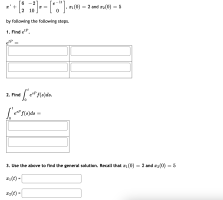Hello!
I am having trouble with a problem on my homework set. The general topic is on Non-Homogeneous Linear Systems of ODE. The subtopic is on Variation of Parameters for Non-Homogenous Linear Systems. Our instructor has attached the following text as a reference: https://math.libretexts.org/Bookshe..._Parameters_for_Nonhomogeneous_Linear_Systems.
The Problem
The problem reads:
Solve the system
[math]x'+ \left[\begin{matrix} 6 & -2\\2&10 \end{matrix}\right]x=\left[\begin{matrix} e^{-t}\\0\end{matrix}\right][/math],
[math]x_1(0)=1[/math] and [math]x_2(0)=-3[/math]
by the following steps.
1. Find [math]e^{tP}[/math].
[math]e^{tP}=[/math]
2. Find [math]\int^t_0 e^{sP} f(s) ds[/math].
[math]\int^t_0 e^{sP} f(s) ds=[/math]
3. Use the above to find the general solution. Recall that [math]x_1(0)=1[/math] and [math]x_2(0)=-3[/math].
[math]x_1(t)=[/math][math]x_2(t)=[/math]
My Attempts
Now, I have tried solving for [math]e^{tP}[/math] by solving for the complementary system.
So, taking [math]\left[\begin{matrix} 6 & -2\\2&10 \end{matrix}\right][/math], I insert the λ into the 1st and 4th positions.
Therefore, [math]\left[\begin{matrix} 6-λ & -2\\2&10-λ \end{matrix}\right][/math].
Then, I solved for the eigenvalues by taking the determinant of the new matrix.
[math](6-λ)(10-λ)+4=64-16λ+λ^{2}=(λ-8)^{2}[/math]
Therefore, [math]λ=8,8[/math].
Now, to solve for the first eigenvector K, I take the new matrix and plug in 8 for λ.
Therefore, [math]\left[\begin{matrix} -2 & -2\\2&2 \end{matrix}\right][/math].
Then, I took the first line of the matrix and set it equal to zero: [math]-2k_1-2k_2=0[/math].
Then, I set up the relation [math]-2k_1=2k_2[/math].
If I take [math]k_1=1[/math], then [math]k_2=-1[/math].
Therefore, my first eigenvector is [math]\left[\begin{matrix} 1 \\ -1 \end{matrix}\right][/math].
Because this is a vector, I can scale the vector up by a factor of 2. Therefore, I have [math]\left[\begin{matrix} 2 \\ -2 \end{matrix}\right][/math]
To solve for my second eigenvector, I took the matrix [math]\left[\begin{matrix} -2 & -2\\2&2 \end{matrix}\right][/math] and set it equal to the first eigenvector [math]\left[\begin{matrix} 2 \\ -2 \end{matrix}\right][/math].
Therefore, I have the equation [math]-2p_1-2p_2=2[/math].
Then, I set up the relation [math]-2p_1=2+2p_2[/math]. If [math]p_2=1[/math], then [math]p_1=-2[/math].
Therefore, the second eigenvector is [math]\left[\begin{matrix} -2 \\ 1 \end{matrix}\right][/math].
Now that I have both eigenvectors, and knowing that this is a case of repeated eigenvalues, I can derive the general solution of the complementary system:
[math]\left[\begin{matrix} x \\ y \end{matrix}\right]=c_1\left[\begin{matrix} 2 \\ -2 \end{matrix}\right]e^{8t} +c_2 \left( \left[\begin{matrix} 2 \\ -2 \end{matrix}\right]te^{8t}+\left[\begin{matrix} -2 \\ 1 \end{matrix}\right]e^{8t}\right)[/math].
Now, this is where I am very, very lost.
The online program I am doing my homework on (MOER), can give me the answer key.
The answer they give for the first problem is:
[math]e^{tP}=[/math]
I do not know how to derive these answers. I first assumed I could take my solved general solutions above and just ignore the coefficients, but they do not yield what I want.
Plea for Help
I have been trying to work on these problems for almost a full week now, spending hours a day scouring the internet and textbooks, contacting my professor and going to math tutors but all to no avail.
Any help would be greatly appreciated.
Thank you in advance!
Inquid
I am having trouble with a problem on my homework set. The general topic is on Non-Homogeneous Linear Systems of ODE. The subtopic is on Variation of Parameters for Non-Homogenous Linear Systems. Our instructor has attached the following text as a reference: https://math.libretexts.org/Bookshe..._Parameters_for_Nonhomogeneous_Linear_Systems.
The Problem
The problem reads:
Solve the system
[math]x'+ \left[\begin{matrix} 6 & -2\\2&10 \end{matrix}\right]x=\left[\begin{matrix} e^{-t}\\0\end{matrix}\right][/math],
[math]x_1(0)=1[/math] and [math]x_2(0)=-3[/math]
by the following steps.
1. Find [math]e^{tP}[/math].
[math]e^{tP}=[/math]
2. Find [math]\int^t_0 e^{sP} f(s) ds[/math].
[math]\int^t_0 e^{sP} f(s) ds=[/math]
3. Use the above to find the general solution. Recall that [math]x_1(0)=1[/math] and [math]x_2(0)=-3[/math].
[math]x_1(t)=[/math][math]x_2(t)=[/math]
My Attempts
Now, I have tried solving for [math]e^{tP}[/math] by solving for the complementary system.
So, taking [math]\left[\begin{matrix} 6 & -2\\2&10 \end{matrix}\right][/math], I insert the λ into the 1st and 4th positions.
Therefore, [math]\left[\begin{matrix} 6-λ & -2\\2&10-λ \end{matrix}\right][/math].
Then, I solved for the eigenvalues by taking the determinant of the new matrix.
[math](6-λ)(10-λ)+4=64-16λ+λ^{2}=(λ-8)^{2}[/math]
Therefore, [math]λ=8,8[/math].
Now, to solve for the first eigenvector K, I take the new matrix and plug in 8 for λ.
Therefore, [math]\left[\begin{matrix} -2 & -2\\2&2 \end{matrix}\right][/math].
Then, I took the first line of the matrix and set it equal to zero: [math]-2k_1-2k_2=0[/math].
Then, I set up the relation [math]-2k_1=2k_2[/math].
If I take [math]k_1=1[/math], then [math]k_2=-1[/math].
Therefore, my first eigenvector is [math]\left[\begin{matrix} 1 \\ -1 \end{matrix}\right][/math].
Because this is a vector, I can scale the vector up by a factor of 2. Therefore, I have [math]\left[\begin{matrix} 2 \\ -2 \end{matrix}\right][/math]
To solve for my second eigenvector, I took the matrix [math]\left[\begin{matrix} -2 & -2\\2&2 \end{matrix}\right][/math] and set it equal to the first eigenvector [math]\left[\begin{matrix} 2 \\ -2 \end{matrix}\right][/math].
Therefore, I have the equation [math]-2p_1-2p_2=2[/math].
Then, I set up the relation [math]-2p_1=2+2p_2[/math]. If [math]p_2=1[/math], then [math]p_1=-2[/math].
Therefore, the second eigenvector is [math]\left[\begin{matrix} -2 \\ 1 \end{matrix}\right][/math].
Now that I have both eigenvectors, and knowing that this is a case of repeated eigenvalues, I can derive the general solution of the complementary system:
[math]\left[\begin{matrix} x \\ y \end{matrix}\right]=c_1\left[\begin{matrix} 2 \\ -2 \end{matrix}\right]e^{8t} +c_2 \left( \left[\begin{matrix} 2 \\ -2 \end{matrix}\right]te^{8t}+\left[\begin{matrix} -2 \\ 1 \end{matrix}\right]e^{8t}\right)[/math].
Now, this is where I am very, very lost.
The online program I am doing my homework on (MOER), can give me the answer key.
The answer they give for the first problem is:
[math]e^{tP}=[/math]
| [math](1-2t)e^{8t}[/math] | [math](-2t)e^{8t}[/math] |
| [math](2t)e^{8t}[/math] | [math](1+2t)e^{8t}[/math] |
I do not know how to derive these answers. I first assumed I could take my solved general solutions above and just ignore the coefficients, but they do not yield what I want.
Plea for Help
I have been trying to work on these problems for almost a full week now, spending hours a day scouring the internet and textbooks, contacting my professor and going to math tutors but all to no avail.
Any help would be greatly appreciated.
Thank you in advance!
Inquid

